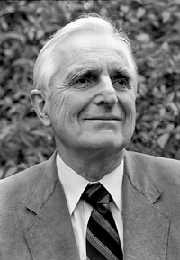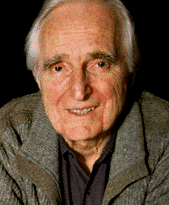Douglas
Engelbart has always been ahead of his time, having idea s
that seemed far-fetched at the time but later were taken for granted.
For instance, as far back as the 1960s he was touting the use of computers
for online conferencing and collaboration. Engelbart's most famous
invention is the computer mouse, also developed in the 1960s, but
not used commercially until the 1980s. Like Vannevar
Bush and J.C.R. Licklider, Engelbart
wanted to use technology to augment human intellect. He saw technology,
especially computers, as the answers to the problem of dealing with
the ever more complex modern world and has dedicated his life to the
pursuit of developing technology to augment human intellect.
s
that seemed far-fetched at the time but later were taken for granted.
For instance, as far back as the 1960s he was touting the use of computers
for online conferencing and collaboration. Engelbart's most famous
invention is the computer mouse, also developed in the 1960s, but
not used commercially until the 1980s. Like Vannevar
Bush and J.C.R. Licklider, Engelbart
wanted to use technology to augment human intellect. He saw technology,
especially computers, as the answers to the problem of dealing with
the ever more complex modern world and has dedicated his life to the
pursuit of developing technology to augment human intellect.
Early
Years
Douglas
Engelbart was born in 1925, in Oregon, where he grew up on a small
farm. In 1942, he graduated high school and went to Oregon State University
to study electrical engineering. His studies were interrupted by WWII.
He joined the Navy and spent two years in the Philippines as a radar
technician. While stationed in the Philippines he read Vannevar Bush's
"As
We may Think." Engelbart would later write to Bush acknowledging
the influence Bush's article had had on his own work. (Zachary,
267).
Engelbart's
Vision
Engelbart
went back to school after the war and received his degree in 1948.
He then went to work for the NACA Ames Laboratory—the pre-cursor
to NASA. By 1950, Engelbart began to grow restless. "I realized that
I didn't have any more goals than a steady job, getting married and
living happily ever after," and he asked himself, "How can my career
maximize my contribution to mankind?" (Engelbart
in O'Brien) He thought about how the world was growing ever more
complex and remembered his experience reading Bush. He began to "envision
people sitting in front of displays, 'flying around' in an information
space where they could formulate and organize their ideas with incredible
speed and flexibility." (Engelbart
bio, Bootstrap Institute). This was, of course, well before the
Internet or World Wide Web came into existence.
With
his new goal in mind, Engelbart enrolled in the graduate program in
electrical engineering at UC Berkeley and earned his Ph.D. in 1955.
He stayed at Berkeley as an Assistant Professor, but soon he realized
that his dreams of using computers to augment human intellect were
to far ahead of the mainstream to be pursued in that setting. Engelbart
left Berkeley and got a research position at the Stanford Research
Institute (SRI)
At
SRI, Engelbart formulated a new discipline aimed helping organizations
keep up with the growing complexity and urgency they were facing with
the exponential growth and development of technology, or as he simply
put it, augmenting human intellect. In 1962, he wrote his seminal
work, Augmenting
Human Intellect: A Conceptual Framework . This paper set out the
basic ideas that have continued to guide Engelbart's work:
"By 'augmenting
human intellect' we mean increasing the capability of a man to approach
a complex problem situation, to gain comprehension to suit his particular
needs, and to derive solutions to problems. Increased capability
in this respect is taken to mean a mixture of the following: more-rapid
comprehension, better comprehension, the possibility of gaining
a useful degree of comprehension in a situation that previously
was too complex, speedier solutions, better solutions, and the possibility
of finding solutions to problems that before seemed insoluble. And
by "complex situations" we include the professional problems of
diplomats, executives, social scientists, life scientists, physical
scientists, attorneys, designers—whether the problem situation
exists for twenty minutes or twenty years. We do not speak of isolated
clever tricks that help in particular situations. We refer to a
way of life in an integrated domain where hunches, cut-and-try,
intangibles, and the human "feel for a situation" usefully co-exist
with powerful concepts, streamlined terminology and notation, sophisticated
methods, and high-powered electronic aids." (Engelbart,
Augmenting Human Intellect: Introduction)
NLS
In
1963, Engelbart set up his own research lab. He called it the Augmentation
Research Center. Throughout the 1960s and 1970s his mlab developed
an elaborate hypermedia—groupware system called NLS (oNLine System).
NLS facilitated the creation of digital libraries and storage and
retrieval of electronic documents using hypertext. This was the first
successful implementation of hypertext. NLS used a new  device
to facilitate computer interaction—the mouse. (The mouse was
not adopted for general use until the 1980s when Apple computers began
using them). NLS also created new graphical user interfaces implementing
a windowing environment and allowed the user to e-mail other users
as well as offering a variety of word processing options. Perhaps
most remarkably, NLS also provided for on-screen video teleconferencing.
All of these technologies, which are now ubiquitous, were truly astonishing
to most back in the 1960s.
device
to facilitate computer interaction—the mouse. (The mouse was
not adopted for general use until the 1980s when Apple computers began
using them). NLS also created new graphical user interfaces implementing
a windowing environment and allowed the user to e-mail other users
as well as offering a variety of word processing options. Perhaps
most remarkably, NLS also provided for on-screen video teleconferencing.
All of these technologies, which are now ubiquitous, were truly astonishing
to most back in the 1960s.
In
1968, at the Fall Joint Computer Conference in San Francisco, Engelbart
demonstrated NLS in a 90 minute multimedia presentation that included
a live video conference with staff members back in his lab 30 miles
away. To this day, Engelbart's demo is still known as "the mother
of all demos." It was truly groundbreaking, but Engelbart was way
ahead of his time. His ideas were to different and new for others
to fully grasp. Paul Saffo of the Institute
for the Future said," "It [the demo] was like a UFO landing on
the White House lawn." (Saffo in
O'Brien). Some people in attendance thought the whole thing was
a hoax.
ARPA
Engelbart
had developed NLS with ARPA funding. He was excited about the new
network ARPA was building. He saw it as a vehicle to extend NLS and
increase distributed collaboration. "I realized there was a ready-made
computer community," said Engelbart. "It was just the thing I was
looking for." (Engelbart in Hafner
& Lyon, 78). SRI, where Engelbart's lab was became the second
node on the ARPANET.
Engelbart
was very involved in the whole project and put together the Network
information Center (NIC) which used NLS as a sort of online  clearinghouse
for ARPANET resources. Larry Roberts, the principal architect of the
ARAPANET, later recalled, " Engelbart at SRI had a hypertext system
that he was using at SRI and we all used it. We arranged with him
to be the document center for the network so all of the documentation,
all of the publications would be online at SRI." (Roberts
in Segaller, 127).
clearinghouse
for ARPANET resources. Larry Roberts, the principal architect of the
ARAPANET, later recalled, " Engelbart at SRI had a hypertext system
that he was using at SRI and we all used it. We arranged with him
to be the document center for the network so all of the documentation,
all of the publications would be online at SRI." (Roberts
in Segaller, 127).
Engelbart
has continued to work on augmenting human intellect, seldom receiving
the acknowledgement many believe he deserves. In 1989, he founded
the Bootstrap Institute to foster high performance organizations by
developing enabling technologies and promoting collaboration. At age
75, his work continues.
For
Further Reading
Bootstrapping:
Douglas Engelbart, Coevolution, and the Origins of Personal Computing

Home|
Vannevar Bush | J.C.R.
Licklider | Larry Roberts | Paul
Baran |
Bob Metcalfe |
Doug Engelbart | Vint Cerf | Ted
Nelson | Tim Berners-Lee |
Marc Andreesen | Epilogue |
References |